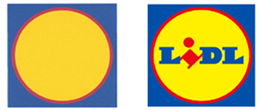Aldi crowned victor in ‘REGENT’ trade mark case
Aldi has finally been victorious in the long-running EU trade mark BISTRO REGENT legal battle.
The Court of Appeal dismisses Tesco’s appeal against a UK High Court judgment of April 2023, which ruled that Tesco’s Clubcard logo infringes Lidl’s copyright and trade mark rights and amounts to passing off.
To recap on proceedings in the High Court, Lidl claimed that Tesco’s use of a yellow circle in a blue square as part of its Clubcard loyalty scheme for shoppers, amounts to passing off and copyright infringement and infringed its registered trade marks in the UK.
Lidl’s registered trade marks:

Tesco’s sign:

The basis for the trade mark infringement claim was Section 10(3) of the UK Trade Marks Act 1994.
This is a reputation-based claim (as opposed to a likelihood of confusion) and requires the proving of (relevant sections to this case highlighted in bold):
Based on the original evidence filed by Lidl, the High Court was satisfied that Lidl’s earlier marks had a reputation in the UK marketplace for supermarket services. The court concluded that the use of the Tesco logos to promote Clubcard price benefits in-store takes unfair advantage of the reputation of the Lidl logos, by benefitting from the power of attraction, reputation, and prestige of the earlier marks and, further, was detrimental to the distinctive character of the earlier marks by way of blurring/dilution in the UK marketplace.
Ultimately, Lidl argued that the repute of the marks was associated with being a well-known discount supermarket and one that Tesco were knowingly taking advantage of.
The court also held that Tesco’s logos were similar to Lidl’s earlier marks and that the visual similarity between the marks was the most important on the basis that the average consumer (supermarket shoppers) would primarily view the logos visually.
Lidl also filed a claim for passing off under Section 10(4) of the Act.
The basis for a passing off claim must prove the following points:
Goodwill itself is a form of intangible property. It is the magnetism that leads consumers to return to the same business or the same product, that ineffable ‘thing’ that is established through geographically intensive, widespread and longstanding use of the sign.
It is important to note that the basis for the claim was not a misrepresentation as to trade origin.
Instead, Lidl successfully argued that consumers would erroneously believe that goods offered under the Tesco Clubcard price would price match or be lower than the price offered at Lidl for equivalent goods. By deceiving consumers, this damages the goodwill established in the goods under the Lidl marks.
Finally, Lidl were also successful in proving a claim to copyright infringement.
This requires the taking of a whole or substantial part of a work, without permission.
For copyright to subsist, work must be original and be the author’s own intellectual creation. Consideration of the creative freedom of the designers in the creation of Lidl’s logos was assessed and it was found that, due to the number of potential combinations of colours/shapes, Lidl’s graphic designers exercised a sufficient expression of intellectual creation.
So how did Lidl prove that Tesco had copied the logos?
In fact, it was Tesco’s inability to prove that they hadn’t copied the logos that gave rise to the court’s finding of copyright infringement.
Evidence filed by Lidl showed that Tesco had access to Lidl’s logos and therefore the burden of proof shifted to Tesco who failed to prove, by evidence, that the Tesco Clubcard logo was created independently and originally from Lidl.
The Court of Appeal delivered a verdict that dismissed Tesco’s appeal against the High Court judgment and ruled a finding of trade mark infringement and passing off.
Justice Lewison concluded in the judgment:
I find myself in the position of Lord Bridge of Harwich in the Jif Lemon case at 495: ‘If I could find a way of avoiding this result, I would. But the difficulty is that the trial judge’s findings of fact, however surprising they may seem, are not open to challenge. Given those findings, I am constrained…to accept that the judge’s conclusion cannot be faulted in law.
With undisguised reluctance I agree…that the appeal should be dismissed.
So why does it appear that the Court of Appeal disagreed with the High Court’s judgment?
The Court of Appeal only deal with whether the first instance decision is rationally insupportable but due to the strength and compelling nature of Lidl’s evidence, Lidl were able to substantiate their claims. The case therefore turned on its facts. On this basis, the High Court judge made findings of fact. Despite the Court of Appeal’s surprise at these findings, Justice Smith’s findings were watertight and cannot be faulted in law.
Tesco will now have the option of seeking permission to appeal at the Supreme Court. However, due to the case being decided on its facts, there is no major legal principle at issue.
Tesco might take some comfort in having the ruling on copyright infringement overturned in their favour, but this seemingly has no effect on the overall outcome of the case who, absent any appeal, must remove all infringing material, pay an amount of damages (which is expected to be in the millions of pounds) and be forced to re-brand.
The case highlights the importance of trade marks (and their get-up) conveying messages to the public other than simply denoting origin. This raises the question around the ‘functions’ of trade marks. If brand owners can show that a sign conveys a strong message to consumers, then this itself has been shown to be protectable by law, particularly via the proviso of Section 10(3) of the Act which deals with cases that do not require the proving of a likelihood of confusion.
If you have a question about this decision or require advice on copyright and trade marks, please contact one of our trade mark attorneys.